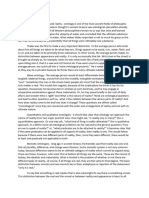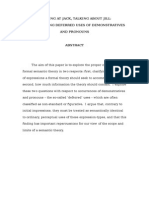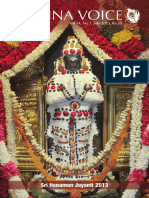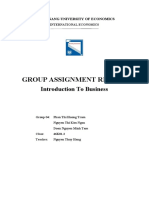Verifiability: Friedrich Waismann
Verifiability: Friedrich Waismann
Uploaded by
dtpblissCopyright:
Available Formats
Verifiability: Friedrich Waismann
Verifiability: Friedrich Waismann
Uploaded by
dtpblissOriginal Title
Copyright
Available Formats
Share this document
Did you find this document useful?
Is this content inappropriate?
Copyright:
Available Formats
Verifiability: Friedrich Waismann
Verifiability: Friedrich Waismann
Uploaded by
dtpblissCopyright:
Available Formats
Verifiability
FRIEDRICH WAISMANN
[This paper was originally the second part of a Symposium in which the first symposiast was Mr. (now Professor) D. M. MacKinnon. It therefore naturally contained several polemical references to Professor MacKinnon's contribution. In tearing the present paper from that context in order to reprint it in this collection, we tried to remove as many of these references as possible; but unfortunately it was not practicable to remove them all without re-writing the entire paper. So we must apologize to Professor MacKinnon; and remind readers that in the interests of the unity of this book he has been denied the right to speak in his own cause.] When we reflect on such a sentence as 'The meaning of a statement is the method of its verification', we should, first of all, be quite clear as to what we mean by the term 'method of verification'. From a logical point of view we are not interested in the various activities that are involved in verifying a statement. What, then, is it we have in mind when we talk of such things? Take an example. Suppose there is a metal ball in front of me, and I have the task of finding out whether the ball is charged with electricity. To do that I connect the ball with an electroscope and watch whether the gold leaves diverge. The statement 'The gold leaves of the instrument diverge' (s) describes the verification of the statement 'The ball is charged' (p). Now what exactly am I doing when I describe the verification of the statement p? I establish a connection between two statements by declaring that the one (s) is to follow from the other (p). In other words, I lay down a rule of inference which allows me to pass from the statement 'The ball is charged with electricity' to another that describes an observable situation. By doing this I connect the statement with another one, I make it part of a system of operations, I incorporate it into language, in short, I determine the way it is to be used. In this sense giving the verification of a statement is an important part of giving its use, or to put it differently, explaining its verification is a contribution, to its grammar. In everyday life we understand sentences without bothering much as to the way they are verified. We understand them because we understand the single words which occur in them and grasp the grammatical structure of the sentence as a whole. The question of the verification arises only when we come across a new sort of combination of words. If, for instance, someone were to tell us that he owned a dog that was able to think, we should at first not quite understand what he was talking about and would ask him some further questions. Suppose he described to us in detail the dog's behaviour in certain circumstances, then we should say 'Ah, now we understand you, that's what you call thinking'. There is no need to inquire into the verification of such sentences as 'The dog barks', 'He runs', 'He is playful', and so on, as the words are then used as we may say in their normal way. But when we say 'The dog thinks', we create a new context, we step outside the boundaries of common speech, and then the question arises as to what is meant by such a word series. In such cases explaining the verification is explaining the meaning, and changing the verification is changing the meaning. Obviously meaning and verification are connected -- so why say they are not? But when I say that the statement p is connected with the statements s1, s2 . . . sn which describe evidences for it, I do not say that p is identical with sl, s2 . . . sn or their conjunction.1 To say this
would only be true if s1, s2 . . . sn or their conjunction entailed p. Now is that so? There may be statements which are nothing more than abbreviations for all that which is unfolded in their verification. There are, however, other sorts of statements of which this is certainly not true. Recent discussions on phenomenalism, for example, tend to show that no conjunction or disjunction of sense-datum statements, however complex, entails the existence or the nonexistence of a certain material object. If that is so, a material object statement, though it is connected with sense-datum statements, is not just an abbreviation for them, rather has it a logical status of its own, and is not equivalent to any truth-function of the latter ones. I think that the result of these discussions is essentially right, and I ask for permission, to make my point quite clear, to add one word more. The failure of the phenomenalist to translate a material object statement into terms of sense-data is not, as has been suggested, due to the poverty of our language which lacks the vocabulary for describing all the minute details of sense experience, nor is it due to the difficulties inherent in producing an infinite combination of sense-datum statements though all these things may contribute to it. In the main it is due to a factor which, though it is very important and really quite obvious, has to my knowledge never been noticed -- to the 'open texture'2 of most of our empirical concepts. What I mean is this: Suppose I have to verify a statement such as 'There is a cat next door'; suppose I go over to the next room, open the door, look into it and actually see a cat. Is this enough to prove my statement? Or must I, in addition to it, touch the cat, pat him and induce him to purr? And supposing that I had done all these things, can I then be absolutely certain that my statement was true? Instantly we come up against the well-known battery of sceptical arguments mustered since ancient times. What, for instance, should I say when that creature later on grew to a gigantic size? Or if it showed some queer behaviour usually not to be found with cats, say, if, under certain conditions, it could be revived from death whereas normal cats could not? Shall I, in such a case, say that a new species has come into being? Or that it was a cat with extraordinary properties? Again, suppose I say 'There is my friend over there'. What if on drawing closer in order to shake hands with him he suddenly disappeared? 'Therefore it was not my friend but some delusion or other.' But suppose a few seconds later I saw him again, could grasp his hand, etc. What then? 'Therefore my friend was nevertheless there and his disappearance was some delusion or other.' But imagine after a while he disappeared again, or seemed to disappear -- what shall I say now? Have we rules ready for all imaginable possibilities? An example of the first sort tends to show that we can think of situations in which we couldn't be certain whether something was a cat or some other animal (or a jinni). An example of the second sort tends to show that we can consider circumstances in which we couldn't be certain whether something was real or a delusion. The fact that in many cases there is no such thing as a conclusive verification is connected with the fact that most of our empirical concepts are not delimited in all possible directions. Suppose I come across a being that looks like a man, speaks like a man, behaves like a man, and is only one span tall -- shall I say it is a man? Or what about the case of a person who is so old as to remember King Darius? Would you say he is an immortal? Is there anything like an exhaustive definition that finally and once for all sets our mind at rest? 'But are there not exact definitions at least in science?' Let's see. The notion of gold seems to be defined with absolute precision, say by the spectrum of gold with its characteristic lines. Now what would you say if a substance was discovered that looked like gold, satisfied all
the chemical tests for gold, whilst it emitted a new sort of radiation? 'But such things do not happen.' Quite so; but they might happen, and that is enough to show that we can never exclude altogether the possibility of some unforeseen situation arising in which we shall have to modify our definition. Try as we may, no concept is limited in such a way that there is no room for any doubt. We introduce a, concept and limit it in some directions; for instance, we define gold in contrast to some other metals such as alloys. This suffices for our present needs, and we do not probe any farther. We tend to overlook the fact that there are always other directions in which the concept has not been defined. And if we did, we could easily imagine conditions which would necessitate new limitations. In short, it is not possible to define a concept like gold with absolute precision, i.e. in such a way that every nook and cranny is blocked against entry or doubt. That is what is meant by the open texture of a concept.
You might also like
- Lab Equipment PowerpointDocument43 pagesLab Equipment Powerpointangelo tonogbanua100% (2)
- Meaning and Intentionality in Wittgenstein's Later PhilosophyDocument13 pagesMeaning and Intentionality in Wittgenstein's Later PhilosophyidquodNo ratings yet
- Ayurvedic Tablet FormulationDocument32 pagesAyurvedic Tablet Formulation0921py75% (4)
- Waismann VerifiabilityDocument20 pagesWaismann VerifiabilitySextus EmpiricusNo ratings yet
- Ayer - Demonstration of The Impossibility of MetaphysicsDocument11 pagesAyer - Demonstration of The Impossibility of MetaphysicsabbraxasNo ratings yet
- 1meaning and VerificationDocument21 pages1meaning and VerificationycuerleeNo ratings yet
- The World of UniversalsDocument4 pagesThe World of UniversalswalczakcNo ratings yet
- OntologyDocument5 pagesOntologyhikariisetsuyaNo ratings yet
- Charles Travis - Wittgenstein Cryst Pur8Document15 pagesCharles Travis - Wittgenstein Cryst Pur8David DevalleNo ratings yet
- Words and Objects - 2000Document26 pagesWords and Objects - 2000robpunNo ratings yet
- (P. F. Strawson) Entity and Identity and Other EssayDocument120 pages(P. F. Strawson) Entity and Identity and Other Essayjoaquingalindo0% (1)
- Pointing at Jack M&LDocument47 pagesPointing at Jack M&LHassan KhaireldeenNo ratings yet
- About Language GamesDocument16 pagesAbout Language GamesCarlos CavalcanteNo ratings yet
- Carnap Elimination of MetaphysicsDocument11 pagesCarnap Elimination of MetaphysicsMauro Zapata100% (1)
- 3 - DualismDocument17 pages3 - DualismMagharibaNo ratings yet
- Why Meaning (Probably) Isn't Conceptual RoleDocument13 pagesWhy Meaning (Probably) Isn't Conceptual RoleLívia MesquitaNo ratings yet
- Ineffability: The Very Concept: Published Online: 14 March 2020Document12 pagesIneffability: The Very Concept: Published Online: 14 March 2020Milica Vukovic StamatovicNo ratings yet
- Austin Performative UtterancesDocument14 pagesAustin Performative UtterancesArvind RajagopalNo ratings yet
- The Distinction Between Semantics and Pragmatics 1n5ehuqDocument38 pagesThe Distinction Between Semantics and Pragmatics 1n5ehuqA.ASKANo ratings yet
- PERFORMATIVE UTTERANCES J L AustinDocument18 pagesPERFORMATIVE UTTERANCES J L AustinΚώστας Μπαλιώτης100% (1)
- How To Do Things With WordsDocument5 pagesHow To Do Things With WordsjyotiNo ratings yet
- Logic of Phantasy 61Document5 pagesLogic of Phantasy 61Chun-hsiung ChenNo ratings yet
- Sentences, Judgments, RealityDocument8 pagesSentences, Judgments, RealityThaddeusKozinskiNo ratings yet
- Arguments Truth and ValidityDocument9 pagesArguments Truth and ValidityAd HaNo ratings yet
- Logic of Phantasy 79Document5 pagesLogic of Phantasy 79Chun-hsiung ChenNo ratings yet
- The Semantic Theory of TruthDocument8 pagesThe Semantic Theory of TruthfaridNo ratings yet
- The Picture TheoryDocument7 pagesThe Picture TheoryInmaculada Rodriguez RuizNo ratings yet
- Making History 2nd Edition by Bruce Olav Solheim All Chapter Instant DownloadDocument34 pagesMaking History 2nd Edition by Bruce Olav Solheim All Chapter Instant Downloadamizicmodna100% (2)
- SWIWKO 2v1Document18 pagesSWIWKO 2v1Syed Sibtain AliNo ratings yet
- After AllDocument7 pagesAfter AllGodwin MasulaNo ratings yet
- Karim - Advanced MetaphysicsDocument11 pagesKarim - Advanced Metaphysicsalican karimNo ratings yet
- Russell On The Relation of Universals and ParticularsDocument14 pagesRussell On The Relation of Universals and ParticularsJay Kennedy100% (1)
- Gennaro Chierchia (1989) Anaphora and Attitude de SeDocument29 pagesGennaro Chierchia (1989) Anaphora and Attitude de SejacoporomoliNo ratings yet
- RmsacceptanceDocument16 pagesRmsacceptanceapi-339415958No ratings yet
- The Refutation of Relativism by JohnR+SearleDocument5 pagesThe Refutation of Relativism by JohnR+SearleRedbronsonNo ratings yet
- Replies para A Discussão Na Lógica Colin MC GinnDocument10 pagesReplies para A Discussão Na Lógica Colin MC GinnbrunnohpacerNo ratings yet
- (Peter Glassen) The Senses of Ought (BookFi)Document7 pages(Peter Glassen) The Senses of Ought (BookFi)Cee TeeNo ratings yet
- Chap2 Austin TruthDocument18 pagesChap2 Austin TruthCarolina CMNo ratings yet
- Book-Introduction The Five Key Terms of Dramatism (MDesIxD)Document5 pagesBook-Introduction The Five Key Terms of Dramatism (MDesIxD)T CNo ratings yet
- Blackburn - 1991 - Reply To SturgeonDocument4 pagesBlackburn - 1991 - Reply To SturgeonPablo StafforiniNo ratings yet
- IMPLICATUREDocument5 pagesIMPLICATURERahul MahashabdeNo ratings yet
- Aristotle InterpretationDocument28 pagesAristotle Interpretationمصطفى رجوانNo ratings yet
- (Ebook) (Philosophy of Language) Cora Diamond - The Realistic Spirit-Chpt1Document36 pages(Ebook) (Philosophy of Language) Cora Diamond - The Realistic Spirit-Chpt1Ek RzepkaNo ratings yet
- Logic: A Brief IntroductionDocument21 pagesLogic: A Brief IntroductionPhương NguyễnNo ratings yet
- Complete Philosophical and Theological Treatises of Anselm of CanterburyDocument33 pagesComplete Philosophical and Theological Treatises of Anselm of CanterburyLessandroCostaNo ratings yet
- Ebooks File Mechanical Engineers Handbook 4 Volume Set 4th Edition Volume 1 All ChaptersDocument34 pagesEbooks File Mechanical Engineers Handbook 4 Volume Set 4th Edition Volume 1 All Chaptersauroyeson100% (2)
- The Philosophy of Language Is Even Less WellDocument6 pagesThe Philosophy of Language Is Even Less Wellyohanisrongrem2No ratings yet
- JH Reply To DancyDocument11 pagesJH Reply To DancyJohn HymanNo ratings yet
- Logic of Phantasy 58Document5 pagesLogic of Phantasy 58Chun-hsiung ChenNo ratings yet
- Annotated-Suckow - Jonathan - Final 2Document3 pagesAnnotated-Suckow - Jonathan - Final 2jonathan suckowNo ratings yet
- Some Sub-Atomic Particles of Logic: R. M. HareDocument15 pagesSome Sub-Atomic Particles of Logic: R. M. HareDaniele ChiffiNo ratings yet
- Impliciture vs. ExplicatureDocument8 pagesImpliciture vs. ExplicatureJohann Sebastian MastropianoNo ratings yet
- Culler Jonathan Philosophy and Literature The Fortunes of The PerformativeDocument17 pagesCuller Jonathan Philosophy and Literature The Fortunes of The PerformativeFernanda DrummondNo ratings yet
- Searle, 2004, Perception, in MindDocument19 pagesSearle, 2004, Perception, in Mindcheby92100% (1)
- Instant Access To (Ebook PDF) South-Western Federal Taxation 2018: Corporations, Partnerships, Estates and Trusts 41st Edition Ebook Full ChaptersDocument25 pagesInstant Access To (Ebook PDF) South-Western Federal Taxation 2018: Corporations, Partnerships, Estates and Trusts 41st Edition Ebook Full Chaptersglenzadzman100% (5)
- Events and Things _ Issue 15 _ Philosophy NowDocument5 pagesEvents and Things _ Issue 15 _ Philosophy NowKomkor GuyNo ratings yet
- 08a-Foucault-121785-Eng Rev 2022Document22 pages08a-Foucault-121785-Eng Rev 2022Carlacarla2001No ratings yet
- JAGBPA.1Document18 pagesJAGBPA.1patwary.mahmudalhaqNo ratings yet
- Denotation and ConnotationDocument15 pagesDenotation and ConnotationLiezel Evangelista BaquiranNo ratings yet
- Contraindications For ExtractionDocument3 pagesContraindications For ExtractionZhuoYuan How100% (4)
- Sherman MorrisonDocument7 pagesSherman MorrisonFernando BatistaNo ratings yet
- THORNOVA TS-BGT72 (560-580) v2023.9.13Document2 pagesTHORNOVA TS-BGT72 (560-580) v2023.9.13diegopavisich3752No ratings yet
- Java Excel API Tutorial FullDocument10 pagesJava Excel API Tutorial Fullagourram20140% (1)
- CV-MMM - CeDocument7 pagesCV-MMM - CeMudassirNo ratings yet
- Latest Proposal 2.0Document33 pagesLatest Proposal 2.0Nurul Farhana Binti Md Noor J21A0933No ratings yet
- Batari Group Presentation (BJM) Dec 2020 3.0Document43 pagesBatari Group Presentation (BJM) Dec 2020 3.0Lintas Jalur AndalanNo ratings yet
- 566 LIC Expt 2Document22 pages566 LIC Expt 2Hrivu Dasmunshi (RA1911004010566)No ratings yet
- Krishna Voice July 2013Document27 pagesKrishna Voice July 2013Ram SanyalNo ratings yet
- Assignment Computer VisionDocument4 pagesAssignment Computer Visionsheraz7288No ratings yet
- PG Discover FinalDocument27 pagesPG Discover FinalMeyyappan KNo ratings yet
- Ahts DP2Document6 pagesAhts DP2CESAR VIECNTENo ratings yet
- Audi - A5 (8T) - 2007-2011 - Ss-At - A96Document15 pagesAudi - A5 (8T) - 2007-2011 - Ss-At - A96sologiuc.adrian3bNo ratings yet
- Commando, Fleetwing BT 12, Douglas A 20 Havoc,: JL Mcclellan: P51 Draft P 1 of 32Document32 pagesCommando, Fleetwing BT 12, Douglas A 20 Havoc,: JL Mcclellan: P51 Draft P 1 of 32Kliment VoroshilovNo ratings yet
- Internshi 2K23 OMKAR GADE XEROX REPORTDocument53 pagesInternshi 2K23 OMKAR GADE XEROX REPORTomkar G.No ratings yet
- Brașov, Romania To Brașov, Romania - Google Maps PDFDocument13 pagesBrașov, Romania To Brașov, Romania - Google Maps PDFAndrei MosoraNo ratings yet
- Group Assignment Report: Introduction To BusinessDocument6 pagesGroup Assignment Report: Introduction To BusinessTrâm PhanNo ratings yet
- Physics BasicsDocument21 pagesPhysics BasicsAbraham RobinsonNo ratings yet
- Sphota Doctrine in Sanskrit Semantics Demystified by Joshi N.R.Document16 pagesSphota Doctrine in Sanskrit Semantics Demystified by Joshi N.R.PolisettyNo ratings yet
- Belsil SiliconesDocument39 pagesBelsil SiliconesWang SeasonNo ratings yet
- SG-12 Safety Guideline For Demolition of Building and Structure-Final NewDocument39 pagesSG-12 Safety Guideline For Demolition of Building and Structure-Final Newraji100% (1)
- Is 9921 5 1985 PDFDocument13 pagesIs 9921 5 1985 PDFsridharNo ratings yet
- 02b Vedic Astrology of MoonDocument79 pages02b Vedic Astrology of MoonPS DebNo ratings yet
- Gleaning Information Using Text StructureDocument16 pagesGleaning Information Using Text StructureeinnocsolracNo ratings yet
- CHE 126 Note 1Document33 pagesCHE 126 Note 1BishopNo ratings yet
- Astm D2613Document5 pagesAstm D2613Kevin RojasNo ratings yet
- Chapter # 4 Networking and The The InternetDocument27 pagesChapter # 4 Networking and The The InternetMikasa AckermanNo ratings yet
- Indices & SurdsDocument12 pagesIndices & Surdsisele1977No ratings yet

























































































